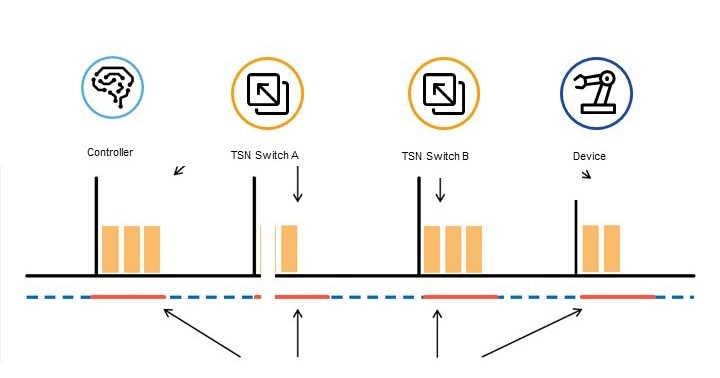A new airport’s baggage handling system failed and was ultimately scrapped after
costing more than $200 million to build. At the time, industry rumor was that the cause of
its malfunction was reliance on a high-level operating system (OS) used in computing instead of a
real-time operating system (RTOS) suited for industrial automation.
Other factors were ultimately implicated as the decisive factors, but the OS hypothesis rang true.
A high-level OS is designed to maximize computing throughput, whereas an RTOS is optimized to
constrain latency. In an industrial setting, timing of tasks is critical. What matters isn’t how
many bags’ carousel routes can be computed per hour. Instead, what matters is whether a bag can be
switched from the conveyor belt to the right carousel before reaching the end of the belt. A
high-level OS is optimized for the former type of problem and an RTOS for the latter.

A challenge arises when a system requires both the rich operating environment a high-level OS
provides and the time-criticality of an RTOS. Industrial companies increasingly are merging the
domains of operating technology (OT) served by real-time systems and information technology (IT)
served by computing systems. I previously discussed this merger in a
blog post about
time-sensitive networking (TSN) and the support for TSN Ethernet built into the Layerscape LS1028A
processor. NXP has subsequently added TSN support to i.MX applications processors. To address a
comparable merging with processing, NXP offers its real-time edge software, which includes options
for the Linux® kernel with real-time extensions and the Jailhouse hypervisor. This
software is a successor to OpenIL, which I covered in a previous
blog post. What
follows is my colleague Naveen Bharadwaj Vyakaranam's discussion of the real-time edge software.
NXP Real-Time Edge Software
As noted above, industrial-automation systems may need to perform time-critical tasks in parallel
with other tasks. Different hardware, such as a microprocessor and a microcontroller, could be
dedicated to each. It would be ideal, however, to implement both real-time and other tasks on the
same processor, but real-time performance must not be degraded. Commercial software is available
to address these requirements. However, there is a growing desire to embrace an open-ended,
flexible, secure and scalable system architecture as industrial-system developers wish to deploy
control systems on cross-compatible platforms to reduce cost, simplify maintenance and leverage
the ever-expanding open-source market to meet future demands.
To demonstrate our continued commitment to meet the growing needs of industrial customers, we
recently announced general availability of our
real-time edge software. With this release, we enable customers to build their real-time applications on open-source
Linux® with real-time support. OEM interest in Linux is due to its openness,
community support and the desire to have technology less proprietary. Through the launch of NXP’s
real-time edge software, we give developers the choice and flexibility to achieve these goals
while maintaining the latency and reliability needs of the application workloads.

NXP's real-time edge software provides a secure, open-source real-time Linux environment for
applications that require deterministic latency and high reliability to deliver an efficient and
fault-tolerant automated industrial control system. Typical applications include industrial
internet of things (IIoT) or Industry 4.0 systems in fields such as industrial, motion control,
building automation, pro-audio and auto/aero infotainment systems.
The three key components of NXP real-time edge software are: the real-time system, communication
protocols and TSN, specifically as shown in Figure 1 and discussed below. The software supports
many NXP i.MX and Layerscape reference design boards out of the box. These incorporate many of the
interfaces that are used in industrial equipment, making efficient evaluation of the features of
NXP SoCs and software enablement straightforward. NXP technology also facilitates developing a
system conforming to IEEE/IEC60802 or other profiles. Building on OpenIL, NXP delivers the
real-time edge software release in a Yocto build system running in conjunction with NXP’s standard
Yocto-based Linux SDK.

Figure 1: Real-Time Edge Software System Block Diagram
Real-Time System
The real time system is a flexible, heterogenous architecture that allows the choice between RT
Linux, Jailhouse (which enables different OSs to run on different cores simultaneously), running
applications on bare metal (e.g., in a u-boot-like framework), or a combination of these
approaches. With this architectures, customers can continue to run an RTOS distribution of their
choice along with their applications in Jailhouse and plan their transition to Linux RT or a bare
metal framework with little or no disruption to their current deployment plans.
Communication Protocols
The real-time edge software supports commonly used industrial communication protocols, such as
EtherCAT®, FlexCAN®, CANopen®, OPC UA and Modbus.
These protocols help interconnect various nodes, such as systems, interfaces and instruments, in
an industrial-control system. [For more on OPC UA and how can work with TSN in service of Industry
4.0, see the
NXP white paper.]
These protocols bring unique advantages to deliver deterministic and time-bound
delivery of real-time workloads across the network and enable the control systems to function
efficiently and optimally.
NXP’s real-time edge software also supports low-power wireless communication protocols, such as
Zigbee®, BLE, NFC along with latest Wi-Fi standards, giving customers a broad
choice of connectivity to fulfill their end-application needs. Complementing our portfolio of
microprocessors and microcontrollers, NXP offers a broad portfolio of wireless products see
see nxp.com/wireless.
Time-Sensitive Networking
To provide deterministic Ethernet networking for industrial applications, IEEE has defined
time sensitive networking. NXP’s TSN-capable SoCs help customers to build systems which conform to
IEEE/IEC60802 or other TSN profiles. The real-time edge software’s integrated TSN protocols offer
reliability, redundancy, low, deterministic latency and resource management for real-time
applications defined under various TSN profiles.
Figure 2 below illustrates how TSN in conjunction with precision timing protocol (PTP/IEEE1588v2)
allows reservation of a time window for each node on the network to send time sensitive data,
which eliminates bandwidth contention on Ethernet.

Figure 2: Ethernet TSN. The solid red line represents the reserved time window for each node to
communicate without contending for bandwidth.
Conclusion
In summary, NXP’s real-time edge software supports heterogenous OS architectures, a suite of
industrial protocols and Ethernet TSN. It offers flexibility and choice to customers implementing
open, secure, reliable and scalable industrial automated control systems in a cost-effective
manner. The software complements NXP’s broad portfolio of microcontrollers, microprocessors and
wireless products and builds on NXP’s familiar Linux SDK. Companies participating in Industry 4.0
and seeking to modernize factories by imbuing industrial equipment with smarts and converging IT
and OT domains will benefit from the software. So, too, will companies simply seeking to transport
baggage through an airport.
To learn more please visit,
NXP Real-Time Edge Software.
Supported Devices
Naveen Bharadwaj Vyakaranam, Senior Product Manager - MPU Enablement software and strategy.








